
Related
Guests
- Philip Zimbardocreator of the landmark Stanford Prison Experiment. He is professor emeritus of psychology at Stanford University. Zimbardo is the author of the best-selling introductory psychology textbook, Psychology and Life, as well as Shyness. He recently served as the president of the American Psychological Association and is now director of the new Center for Interdisciplinary Policy Education and Research on Terrorism.
In 1971, psychology professor Philip Zimbardo created the Stanford Prison Experiment in which 24 college students were randomly assigned the roles of prison guards and prisoners at a makeshift jail on campus. The experiment was scheduled to run for two weeks. By day two, the guards were going far beyond just keeping the prisoners behind bars. In scenes eerily similar to Abu Ghraib, prisoners were stripped naked, bags put on their heads and sexually humiliated. The two-week experiment had to be canceled after just six days. Zimbardo tells the full story of the landmark study in his new book, “The Lucifer Effect.” [includes rush transcript]
Transcript
AMY GOODMAN: As the United States enters the fifth year of the occupation of Iraq, some of the most enduring images of the war remain the vivid photographs of U.S. soldiers torturing Iraqi prisoners at Abu Ghraib. The pictures were leaked to the press and first revealed to the world in May of 2004. Images showed Iraqis with bags over their heads, beaten, set upon by dogs, forced into sexually humiliating acts. The Bush administration tried to paint the scandal as an isolated incident committed by rogue soldiers. But who’s really to blame for the abuses at Abu Ghraib? The answer may lie in a landmark study conducted more than three decades ago.
In 1971, psychology professor Philip Zimbardo created an experiment at Stanford University in which 24 male college students were randomly assigned the roles of prison guards and prisoners at a makeshift jail on campus, actually in the psychology building. The experiment was scheduled to run for two weeks. By day two, the guards were going far beyond keeping the prisoners behind bars. In scenes eerily similar to Abu Ghraib, prisoners were stripped naked, bags put on their heads and sexually humiliated. The guards had become dangerously sadistic, and the prisoners were breaking down emotionally. The two-week experiment had to be canceled after just six days.
Professor Philip Zimbardo has just written a new book that for the first time tells the full story of the famed Stanford prison experiment. It’s called The Lucifer Effect: Understanding How Good People Turn Evil. Professor Zimbardo joins us today from the firehouse studio in New York. He’s professor emeritus of psychology at Stanford University, where he’s taught for the last half-century. He delivered his final lecture there earlier this month. Professor Zimbardo also recently served as president of the American Psychological Association and is now director of the new Center for Interdisciplinary Policy Education and Research on Terrorism.
We welcome you to Democracy Now!, Professor Zimbardo.
PHILIP ZIMBARDO: Welcome, Amy. I’m so happy to be here. Thank you.
AMY GOODMAN: Well, why don’t you begin by just explaining, setting the stage for us, how did this experiment begin?
PHILIP ZIMBARDO: The experiment is really a study in how ordinary people, even good people, can be seduced or corrupted by powerful social situations. What we did was, we began by selecting two dozen people, as you indicated, from among 75 who had answered an ad I placed in the city newspaper. And the ad simply said, “Wanted: College students for study of prison life. Expected to run for two weeks.”
We gave them a battery of psychological tests, interviews, because we wanted to start our prison filled only with good apples, if you will—that is, normal, healthy young men, college students, a little more intelligent than the average public, but ordinary, healthy young men. And then what we did, what is critical to all research, we randomly assigned these young men to two roles, either prisoner or guard, literally by a flip of the coin.
And so, at the beginning of the study, we had only normal, healthy kids playing the role of prisoners and guards. And we had—you know, we had all the props. They had—the guards wore uniforms with the symbols of power, billy clubs, silver reflecting sunglasses—an idea I got from the movie Cool Hand Luke. And that was to make them anonymous. And then the prisoners just had smocks on with numbers. And for the prisoners, we took away their—
AMY GOODMAN: Professor Zimbardo, I wanted to step back for a minute.
PHILIP ZIMBARDO: Yeah.
AMY GOODMAN: How the prisoners, the students who played the prisoners, how they even got to the psychology building, which was the setting for all of this?
PHILIP ZIMBARDO: What was critical in the study is we wanted the boys who were going to be prisoners to have their freedom taken away, rather than have them come and say, “I’m here to be in the study.” So I recruited the Palo Alto Police Department to make very realistic, serious arrests of each student, either in a dormitory or at home. And the police went there, knocked on the door, said, “Is Billy Smith here? He’s wanted for violation of Penal Code 459, armed robbery, or breaking and entering,” handcuffed the kids, put them in a squad car. The sirens are wailing. Neighbors are looking. Obviously they didn’t know it was an experiment.
They bring them down to the police department of the—in City Hall, and they go through a formal booking, meaning a fingerprinting, take their picture. And essentially, although the kids knew they had not been involved in armed robbery, nevertheless they felt guilty, guilty about being in a squad car, people looking in the window, guilty about being in a police station. And the policemen were as deadly serious as they could be, in part because we had a local TV cameraman there filming it.
AMY GOODMAN: Professor Zimbardo, we’re going to break, but when we come back, we’ll go to the makeshift prison. I’ll have you describe it to us. And then we’ll talk about how the prisoners became increasingly afraid, passive, and how the prison guards became increasingly sadistic. We’re talking to Professor Philip Zimbardo. We’ll be back in a minute.
[break]
AMY GOODMAN: We continue this discussion about this landmark experiment. It has been written about by the man who conducted it, Philip Zimbardo, The Lucifer Effect: Understanding How Good People Turn Evil. Professor Zimbardo is in the firehouse studio in New York. Professor Zimbardo, so lay out the psychology building and how you set up this prison to feel so much, for both the guards and the prisoners, the students who were playing them, as a jail.
PHILIP ZIMBARDO: Well, there are two things about a prison. One is the physical aspects of it. So, we took a basement, which were offices that students usually used. We took off the doors. We put new doors on with bars. We took a closet and converted it to solitary confinement, meaning a small, tight, dark space, which had a label on, “The Hole.” We had quarters where the guards came and changed. We had—I was the superintendent of the prison, and we had a warden, David Jaffe, a student, in his office. We had a place where visitors could come. We had a place where we would have the parole board hearings. So, we created a very—a simulated physical environment. And at one end of the hall we had a little window that we could look through watching what was happening with a TV camera. It was covered with theatrical scrims, so they never knew when they were being observed and when they were being filmed.
The psychology—psychological aspect of a prison is more subtle. Before I began the experiment, I taught a summer course at Stanford called “The Psychology of Imprisonment” with Carlo Prescott. He was both a consultant to my study and a young man who had just been released from prison after 17 years. So he was our consultant, but also he was the head of the parole board. Ironically, his parole had been denied for 17 previous years. And what we wanted to do was create essential psychology of imprisonment, and that’s all about power. Every prison is about power. Guards have to assume more and more power and domination, and prisoners have to have their power stripped away. And so that is the ultimate evil of prison. It’s all about power, dominance and mastery. And that was the same thing we found in Abu Ghraib prison.
But also—so the way that power evolves is, the prisoners have to be ultimately dehumanized. You have to think of them as not your kind, not your kin, as—ultimately, you end up thinking of them as animals. And the guards have to be impersonal, distant. Whatever humanity they have when they’re home, when they’re with their families, that has to be suspended, put on a hook, because what they have to do is treat other people in ways that they don’t treat anyone else, those other people being prisoners.
And so, we’re talking about playing a role, anonymity, dehumanization, and then, of course, there’s things like being a team member. The guards have to develop a sense of camaraderie. Most of the evil in the world comes about not out of evil motives, but somebody saying, you know, “Get with the program. Be a team player.” This is what we saw at Enron. This is what we saw in the Nixon administration with their scandal. And I think you’re seeing it now with the current administration.
So, it’s that set of social psychological variables. Oh, the key one is, of course, diffusion of responsibility, that when a person feels, “I am not personally responsible, I am not accountable, it’s the role I’m playing, or these are the orders I had gotten,” then you allow yourself to do things you would never do under ordinary circumstances.
So, it’s that mix of the physical environment, the psychological environment, which came to be overwhelming. By overwhelming, I mean that each day the guards would escalate their level of abuse, so that initially it was doing push-ups, waking prisoners up in the middle of the night, long counts, and then it got to be personal humiliation, cursing the guards and having them curse each other, then finally it devolved into sexually degrading games.
AMY GOODMAN: Professor Zimbardo, I want to turn to a clip from your documentary, Quiet Rage, that documents the six days of the Stanford prison experiment. In this clip, a Prisoner 8612 decides the only way to get out of prison is to show everyone that he’s gone insane. He begins to play the role of the crazy person, but soon the role becomes too real, and he goes into an uncontrollable rage.
PRISONER 8612: You know, I feel [bleep] up inside. I feel really [bleep] up inside. You don’t know. I gotta go, to a doctor, anything. I can’t stay in there. I’m [bleep] up! I don’t know how to explain it. I’m all [bleep] up inside! I want out! I want out now! God damn it! I’m [bleep] up. You don’t know! You don’t know! I mean, God! I mean, Jesus Christ, I’m burning up inside! Don’t you know? I just [bleep] can’t take it!
AMY GOODMAN: Professor Zimbardo, explain what happened here, and also where were you and how you dealt with this.
PHILIP ZIMBARDO: This young man is Prisoner 8612—in real life, Doug Korpi. He was the first prisoner to be arrested, and he was also the ring leader of a rebellion. He led the prisoners on a rebellion the second morning. He had been a student activist, an antiwar activist, and really a powerful prisoner, with regard to opposing the authority. Remember, this is 1971. All of these kids are antiwar activists, civil rights activists. Everybody’s got hair down to here. You could call them hippies. So these are kids who are against authority, whether they’re prisoners or guards. But the prisoners really rebelled against the limits on their freedom.
And the guards just singled him out and harassed him and hassled him. And he had never been in a situation in which, when he did something that the authorities didn’t like, they punished his cellmates, so that his cellmates started putting pressure on him: “Come on, straighten up, fly right.” And he just gave in. That is, he gave in psychologically because his will to resist was being systematically crushed. He broke in 36 hours. The scene you just saw was at the end of only 36 hours into this study, and—but those 36 hours are every minute. That is, prisoners, when they go to sleep, the guards woke them up every two hours to do counts, to do menial exercises. And he set the image of how you escape from the prison, because each day after that, another prisoner had a similar reaction. And so, at the end of five days, we had five kids, kids we chose because they were normal and healthy, having emotional breakdowns.
AMY GOODMAN: Let’s turn to another clip of the documentary Quiet Rage, which you narrated. Here, all the prisoners, but one, Prisoner 819, are lined up for the 11:30 count. They together chant out against Prisoner 819, who had been resisting the guards and is, I think, in solitary confinement. He’s in another room.
PRISONERS: Prisoner 819 did a bad thing. Prisoner 819 did a bad thing. Prisoner 819 did a bad thing. Prisoner 819 did a bad thing.
PHILIP ZIMBARDO: As soon as I realized that 819 could hear this, I rushed to the room where I had left him. And what I found was a boy crying hysterically, while in the background his fellow prisoners were chanting and yelling that he is a bad prisoner and that they were being punished because of him.
PRISONERS: Because of what Prisoner 819 did, my cell is a mess. Because of what Prisoner 819 did, my cell is a mess.
AMY GOODMAN: Professor Zimbardo, can you talk about what happened next?
PHILIP ZIMBARDO: Well, I’m trying to comfort this young man. And he says, “I have to go back.” And I said, “What do you mean?” “I have to prove to them I’m not a bad prisoner.” And at this point I said, “No, you’re not a bad prisoner. You’re Stu. And I’m not the superintendent. I’m Phil Zimbardo. The study is over.” And he kept saying, “No, I have to go back. I’m not a bad prisoner.” And so, the reality of that prison was so deep that even when I’m giving him the opportunity to leave, his reputation, his image as a bad prisoner, has to be undone, has to be reconciled.
And so, it’s so hard, if you’re outside of that situation, to think—how could that happen? These are kids playing cops and robbers. They volunteered for it. It’s an experiment. It’s not a real prison. You know, it’s not real prison bars. It’s just—but once you’re in that setting, and you’re living there day and night—the prisoners lived there around the clock; obviously, guards worked eight-hour shifts—it becomes a total situation in which your identity as a good guard or a bad guard, your identity as a tough guard or a soft guard, becomes really important to you. That’s who you are. You are the guard. You put on the uniform, you put on the glasses, you have the billy club, and that’s who you are. Or you’re in this little—
AMY GOODMAN: Tell us—
PHILIP ZIMBARDO: Yeah.
AMY GOODMAN: Tell us about Prisoner 416, the one who began a revolt by refusing to eat.
PHILIP ZIMBARDO: Well, when we released the first prisoner, 8612, we brought in a substitute. But he came in halfway through. And what’s interesting is, day by day, as the situation degraded, we all adjusted to it. That is, each day’s level of violence, of abuse, was a platform for the next day. But he comes in now, and he’s seeing these crazy things going on, and he says right up front, “I’m not having any of this.” And they told him, “You can’t leave. They won’t let you leave,” which we never said. In fact, 8612 was the one who told him, “They won’t let you out.” And so he says, “I’m going to go on a hunger strike. I’m not going to eat anything, I’ll get sick, and they’ll have to let me go.” And he’s a skinny kid to begin with.
And the guards go crazy, because he’s now the symbol of resistance. All the other kids are broken. If they’re not having emotional breakdowns, they’re like zombies. They’re doing whatever the guards say. And for the next two days, every guard on every shift, their mission is get this prisoner to eat those damned sausages. They put him in solitaire confinement. They make him hold the sausages. And to his credit, he resists. So, he should have been the hero. He should have been the hero for the other prisoners. Instead, he becomes a troublemaker. The guards set the other prisoners against him. They said, “If he doesn’t eat his sausages, you don’t get your visiting hours. If he doesn’t eat his sausages, you guys don’t get your blankets. If he doesn’t eat his sausages, we’re going to put your blankets in nettles and spurs, and you’re going to spend hours digging them out.” So they start jumping all over him. “Eat the damn sausages! You know, you’re ruining our life!”
AMY GOODMAN: I want to turn to another clip of the documentary. Here, the guards force this prisoner, 416, to stand up and sing “Amazing Grace,” as the rest of the prisoners do push-ups.
GUARD: While they do push-ups, you sing “Amazing Grace.” Ready? Down.
PRISONER 416: Amazing grace—
GUARD: Keep going.
PRISONER 416: How sweet the sound, to save a wretch like me—
GUARD: Keep going. “Once I was blind, and now I see.”
PRISONER 416: Once I was blind, but now I see. Since I saw God I’m free.
GUARD: Not bad. Everybody over on your back, on the floor. Oh, stay down there! Stay down there.
AMY GOODMAN: In another incident, a guard uses—tries to use public humiliation and homophobia against Prisoner 416. He tells him to play Frankenstein and to tell another prisoner, 2093, playing the bride of Frankenstein, that he loves him.
GUARD: Four-one-six, since you got your hands in the air, why don’t you play Frankenstein. Two-oh-nine-three, you can be the bride of Frankenstein. You stand here. You go over there. You should act it out. You be the bride of Frankenstein, and you be Frankenstein. I want you to walk over here like Frankenstein and say that you love 2093. That’s not how Frankenstein walks. You have to walk like Frankenstein. We didn’t ask you to walk like you.
PRISONER 416: I love you, 2093.
GUARD: Get up close! Get up close!
PRISONER 416: I love you, 2093. I love you, 2093.
GUARD: You smiled, 2093! You get down here and do 10 push-ups! Two, three, four, five—
AMY GOODMAN: At another point, Prisoner 416 is put in the hole for continuing his hunger strike. In an attempt to get him to submit, one of the guards sets the other prisoners against him. He gives the prisoners a choice.
GUARD: Now, there’s a couple ways that we can do this, depending upon what you want to do. Now, if 416 does not want to eat his sausages, then you can give me the blankets and sleep on the bare mattress. Or you can keep your blankets, and 416 will stay in another day. Now, what will it be?
PRISONER: I’ll keep my blanket.
GUARD: What will it be over here?
PRISONER: I’ll keep my blanket.
GUARD: How about 5486?
PRISONER: I’ll give you my blanket, Mr. Correctional Officer.
GUARD: He don’t want his blanket. Well, now, you boys have got to come to some kind of decision here. What about you, 209? How do you feel about this? We got three in favor of keeping their blankets. We got three against one. Keep your blankets. Four-one-six, you’re going to be in there for a while, so just get used to it.
AMY GOODMAN: Excerpts of the documentary Quiet Rage. This is the filming, actually, of the experiment that was done in 1971. Philip Zimbardo, in a moment we’re going to play the young men, the college students, a few months later, when you interviewed them about what happened. But talk now about what happened here with the prison guard.
PHILIP ZIMBARDO: I must say, 35 years later, it’s really upsetting when I see this. In fact, to prepare myself to write The Lucifer Effect, I went back and looked at—we have12 hours of videos. And it was so depressing, because as I’m watching the videos, I’m saying, “Stop the experiment, stop the experiment. Why are you letting it go on?”
But what happened here is just a demonstration of power run amok, that here was this prisoner—who cares if he eats the lousy sausage? Except it’s what he represents symbolically, that he is resistance. He is the last bastion of resistance to the guards’ power. And they’re doing everything they can to crush him. And he is maintaining this heroic stance. That is, “I will not give in.” And finally, what the guards do is they just use the might of the prisoners—that is, getting other prisoners against him to break his will.
AMY GOODMAN: I wanted to go now to the prisoners and the guards reflecting. Well, this is when they’re back as college students. The documentary, Quiet Rage, includes these post-experiment interviews with the prisoners and the guards. So we go back to this prisoner, 416, recalling the experience two months later.
PRISONER 416: I began to feel that I was losing my identity, the person that I called Clay, the person who put me in this place, the person who volunteered to go into this prison, because it was a prison to me. It still is a prison to me. I don’t look on it as an experiment or a simulation, but just a prison run by psychologists instead of run by the state. I began to feel that that identity, the person that I was, that had decided to go to prison, was distant from me, was remote, until, finally, I wasn’t that. I was 416. I was really my number. And 416 was going to have to decide what to do.
AMY GOODMAN: And here is one of the students, actually, one who played the guards, recalling his role in the Stanford prison experiment, two months later.
GUARD: I had really thought that I was incapable of this kind of behavior. I was surprised. No, I was dismayed to find out that I could really be a—that I could act in a manner so absolutely unaccustomed to anything I would even really dream of doing. And while I was doing it, I didn’t feel any regret, I didn’t feel any guilt. It was only after, afterwards, when I began to reflect on what I had done, that this began to—this behavior began to dawn on me, and I realized that this was a part of me I hadn’t really noticed before.
AMY GOODMAN: Professor Zimbardo, can you respond to what he’s saying today?
PHILIP ZIMBARDO: Yeah. In a broader sense, what the study really gets at, and what I try to capture in the The Lucifer Effect, is that it’s really a celebration of the human mind’s infinite capacity to be kind or cruel, caring or selfish, creative or destructive, to make some of us be villains and some of us heroes. And it all depends on the situation. When we have total freedom, we choose situations that we know we can control. But when we’re in situations where other people are in charge—in the military, in prisons, in some schools, in some families—we are—we can be transformed.
And so, the question is: What makes some people become perpetrators of evil? What makes some people passive in the face of evil? And what I end the book with, that I discovered as I was writing it, is what is the path to heroism. So, the same situation that can inflame a hostile imagination in some, for other people it inspires a heroic imagination. And so, that’s—so now I’m trying to move away from being embedded in evil, which I’ve been studying for 30, 40 years, starting growing up in the South Bronx ghetto, where I was surrounded by evil, to focusing on how can we promote the heroic imagination and heroes in our society.
AMY GOODMAN: We’re going to go to break. When we come back, we’re going to go to one of the most riveting parts of the documentary, when one of these prisoners and one of the guards confront each other. I also want to ask you about what you think of the American Psychological Association’s debate on the issue of torture and participating in it—you were the president of the APA—and about testifying on behalf of one of the guards at Abu Ghraib in his trial. We’re talking to Professor Philip Zimbardo. His book is called The Lucifer Effect: Understanding How Good People Turn Evil. We’ll be back in a minute.
[break]
AMY GOODMAN: This is Democracy Now!, democracynow.org, The War and Peace Report. I’m Amy Goodman. We’re broadcasting from Wisconsin Public Television in Madison. Philip Zimbardo is in the studio, in our firehouse studios in New York. He is the author of The Lucifer Effect: Understanding How Good People Turn Evil, about a prison experiment he conducted 35 years ago at Stanford University, where he paid students $15 a day, a group of students, to be a part of this experiment, where he divided them into guards and prisoners. And that’s what we’ve been talking about for this show. In one of the most riveting parts of the documentary, Professor Zimbardo, you made, called Quiet Rage, this prisoner, 416, and one of the guards confront each other two months after the experiment is over. This is the guard.
GUARD: You put a uniform on and are given a role—I mean, a job, saying, “Your job is to keep these people in line,” then you’re not—certainly not the same person as if you’re in street clothes and in a different role. You really become that person once you put on that khaki uniform, you put on the glasses, you put on—you take the night stick, And, you know, you act the part. That’s your costume. And you have to act accordingly, when you put it on.
PRISONER 416: It harms me.
GUARD: Why?
PRISONER 416: I mean harms. I mean in the present tense, it harms me.
GUARD: How did it harm you? How does it harm you? Just the fact that I—I mean, that people can be like that?
PRISONER 416: Yeah. It let me in on some knowledge that I’ve never experienced firsthand. I’ve read about it. I’ve read a lot about it. But I’ve never experienced it firsthand. I’ve never seen someone turn that way. And I know you’re a nice guy, you know?
GUARD: You don’t know that.
PRISONER 416: You understand? I do. I do know you’re a nice guy.
GUARD: Then why do you hate me?
PRISONER 416: I don’t get that—because I know what you can turn into. I know what you’re willing to do, if you say, “Oh, well, I’m not going to hurt anybody. Oh, well, it’s a limited situation. It’s over in two weeks.”
GUARD: Well, you, in the position, what would you have done?
PRISONER 416: I don’t know. I can’t tell you that I know what I’d do.
GUARD: Would you—
PRISONER 416: I don’t think—I don’t believe I would have been as inventive as you.
GUARD: You mean that—
PRISONER 416: I don’t believe I would have applied as much imagination to what I was doing. Do you understand?
GUARD: Yes, I understand. If you—
PRISONER 416: I think I would have been a guard. I don’t think it would have been such a masterpiece.
GUARD: I didn’t see where it was really harmful. It was degrading, and that was part of my particular little experiment to see how I could—
PRISONER 416: Your particular little experiment? Why don’t you tell me about that?
GUARD: Yes, I was running—I was running little experiments of my own.
PRISONER 416: Tell me about your little experiments. I’m curious.
GUARD: OK. I wanted to see just what kind of verbal abuse that people can take before they start objecting, before they start lashing back—
PRISONER 416: Yeah?
GUARD: —under the circumstances. And it surprised me that no one said anything to stop me. No one said, “Carmen, you can’t say those things to me. Those things are sick.” Nobody said that. They just accepted what I said. I said, you know, “Go tell that man in the face he’s the scum of the Earth,” and they’d do it without question. They’d do push-ups without question. They’d sit in the hole. They’d abuse each other. And here, they’re supposed to have a little—they’re supposed to be together as a unit in jail, but here they’re abusing each other, because I requested them to. And no one questioned my authority at all. And it really shocked me. Why didn’t people—when I started to get—abuse people so much, I started to get so profane that—and still people didn’t say anything.
AMY GOODMAN: Two of the students. One of the students played a guard. One of them played a prisoner. Professor Zimbardo, as we come to the end of this discussion of the experiment, and then I want to go to broader issues, talk about what happened after the six days, and also your response to what these two young men were saying two months after the experiment.
PHILIP ZIMBARDO: Well, I should say, for your listeners, that we ended the two-week study only after six days because it was getting out of control, in the ways you saw and in other ways, even more extreme. But then what we did is we had a whole day, what’s known as debriefing. I met with all the guards, with my staff—Craig Haney, Curt Banks, Carlo Prescott, David Jaffe—and we met with all—first, all the prisoners, to get them to talk about their experiences, to talk to them about—try to defuse some of the tension they felt. And then we met with all the guards separately. And then we brought them all together.
And what I was able to say is, “All of you did some bad things, and all of you saw each other doing bad things. But it’s not diagnostic of any pathology in you, because we picked people who are the most normal and healthy on all psychological measures. It’s really diagnostic of the power of the situation,” so that even though kids had these emotional breakdowns, if you will, there was no lasting effects. We followed these kids up two weeks—we had them all come back two weeks later, a month later. I am still in contact, 35 years later, with many of the former prisoners and guards. And, of course, once you take them out of that situation, once you take them out of their costume—just like soldiers, you take them out of their uniform, put them back in their street clothes—they bounce back to the healthy base rate that they had earlier. So, there were not, surprisingly, any lasting negative effects, which of course makes me feel good.
AMY GOODMAN: What made you stop the experiment? What ultimately made you do that, six days instead of the full two weeks?
PHILIP ZIMBARDO: On the night of the fifth day, I had—I was going to bring in a number of psychologists, graduate students and young faculty, who had no relationship to the study, to interview all of us, so we’d get a fix on how we were doing. And one of the people who came down was a young woman, Christina Maslach, who had been a student of mine, she was now a young professor at Berkeley. And she and I had just started dating; we developed a romantic relationship. And what she saw when she got down there was prisoners lined up, bags over their heads, legs chained, hands on each other’s shoulders, going through counts, guards yelling at them, cursing them.
And I looked up, and I said, “Hey, Chris, look at that.” And she starts tearing up and runs out. And I run after her, and I said, “What’s wrong? This is the crucible of human nature,” and I’m going through all this psychological stuff. And she said, “One minute. What you’re doing to those boys is terrible. They’re not prisoners. They’re not subjects. They are boys, and you are responsible.” And I’m still yelling the whole psychology thing. And she says, “I’m not sure I want to have a relationship with you. I thought you were a loving, caring person. And what I see here is”—I don’t know if she used the word “monster,” but it was the equivalent. And that was like a slap in the face. I said, “Oh, my god, she’s right. I mean, what has happened to me that I have been seduced into being this evil—not evil, just this indifferent authority?” I had become a prison superintendent. So, at that moment, I said, “Study is over.” But this was now the middle of the night, and so we said we’ll end it the next morning, because we had to call all the prisoners who had been released to come back, all the guards on all the guard shifts.
And the interesting last thing is, and made the study so powerful is, halfway through I had a former prison chaplain come down. He interviews all the kids. And he says, “What are you doing to get out?” And they look at him, and he says, “You’ve got to get a lawyer.” Well, he made it even more like a realistic prison. And one of the kids gave him the name of his mother, who has a nephew who’s a lawyer, and the priest actually calls the lawyer, and the public defender comes down this last day. And so, I waited to end the study until after the public defender went through his routine. And he got sucked into the reality of this—reality illusion of this study, by going through his usual public defender role. But then we ended the study, to the joy of not only the prisoners, but to me and my staff—Craig Haney, Curt Banks, Carlo Prescott.
AMY GOODMAN: I wanted to take this story to today. Professor Zimbardo, you testified in the court-martial of the highest-ranking officer implicated in the Abu Ghraib scandal, Staff Sergeant Ivan Frederick.
PHILIP ZIMBARDO: Yes.
AMY GOODMAN: Can you talk about what you said, why you testified? Did you testify on his behalf?
PHILIP ZIMBARDO: Yes, I did. I was part of the defense team. I must say, when I saw those pictures on 20/20—on 60 Minutes, excuse me, the pictures of the abuse, it was—I was shocked, the way most people are. Of course, you know, I saw the parallels immediately with the Stanford prison experiment, visual images. And immediately what happened was, that always happens when there’s a scandal in police departments or in the military, they blame the individual: It’s a few bad apples. In fact, the head of the Joint Chiefs of Staff, General Myers, said, “We know it’s not systemic.” Well, you know, so I said, “Maybe it’s not bad apples. Maybe these really are good American soldiers, and they were put in a bad barrel.” But how would I know?
When I was invited to be on Chip Frederick’s defense team, it meant I had access to him. I could find out everything there was to know about this young man, everything there was to know about the place and the psychological dynamics of the prison. I had access to all the investigative reports. And so, in The Lucifer Effect, I have two whole chapters on what Abu Ghraib really was like and who was—what the situation was like. And then, what was the system? What was the military and Bush administration system that created those horrendous conditions? And so, I testified, essentially, talking about how the situation he was in and the other seven soldiers were in, in the basement of that dungeon, how that corrupted him and made him lose his moral compass.
AMY GOODMAN: So, in the end, Staff Sergeant Ivan Frederick received a maximum eight-year sentence?
PHILIP ZIMBARDO: Even worse. He was dishonorably discharged. He got eight years in prison. They sent him to Kuwait in solitary confinement. They took away 22 years of his retirement pay. This is an all-American, superpatriotic soldier. He had nine medals and awards, which he really prized. And they stripped him publicly to humiliate him. And he’s now in a prison in Leavenworth.
I still have personal contact with him and his family. And I’m saying the sad thing is, the day before he went down to that prison, from everything I know, he was normal, healthy, exactly like one of the good guards in our study. And within a few days, or maybe a few weeks, actually, he and the other military Army reservists—now, these are not “real soldiers,” in quote, these are military police, Army reservists, who have no mission-specific training. They are not trained to do this job.
And he was a guard in a small prison in the States. He now is in charge of a thousand prisoners, 60 Iraqi policemen, who are smuggling weapons in. The place is under constant bombardment. Soldiers are dying, prisoners are dying. He’s working a 12-hour shift, seven days a week for 40 days, without a day off. Incredible. How could anybody—how could any system allow American soldiers to be under that kind of stress? And he and the other soldiers just gave in to the horrors of that situation.
AMY GOODMAN: Professor Zimbardo, who should be held responsible for what happened at Abu Ghraib?
PHILIP ZIMBARDO: Well, my analysis is, individuals are always ultimately personally responsible. He and most of the other military police said, “I’m guilty.” Well, they had to say it, because they’re in the pictures, the—what I call the trophy photos. And he is willing to accept punishment. The situational analysis says we should limit the extent of the punishment, because these are extreme mitigating circumstances. And what I do in The Lucifer Effect, and I have a wonderful website we just put up called LuciferEffect.com, we put the system on trial, to say, if you’re going to put these soldiers, these good American soldiers, on trial for what they did, my argument has been, the people who create this corrupting situation, they have to be put on trial, too. So I have a virtual voting booth in which I put George Tenet on trial, the former head of the CIA; Donald Rumsfeld; Dick Cheney; and President Bush, because, in various ways, they created that situation that corrupted these good American men and women.
AMY GOODMAN: Professor Zimbardo, we have held several debates on the American Psychological Association’s position on psychologists participating in military interrogations, quite different from the American Medical Association, the American Psychiatric Association. Can you comment on the organization you were formerly the president of?
PHILIP ZIMBARDO: Well, I have to begin by saying that psychologists really want to make their research relevant to society, that we want to give back. We get—our research gets funded. Our students get—students’ education gets funded. And so, we are eager to do things—and certainly I, all my life, have tried to make our research relevant to the needs of society. And so, many psychologists are military psychologists. Many psychologists work for the government in various capacities, doing really important good things. Psychologists were critical in the Second World War. And so, some psychologists work to give advice to interrogators about how to be more effective, the same way some psychologists give advice to police detectives on how to be more effective. The problem comes when you’re giving—
AMY GOODMAN: We have 10 seconds.
PHILIP ZIMBARDO: —specific advice about a particular individual being interrogated. And at that point, you step across the line, that you cannot—you cannot abuse your role as psychologist to help an interrogator break a prisoner psychologically. And that, I am strongly against.
AMY GOODMAN: Professor Zimbardo, we’re going to have to leave it there. I want to thank you very much for being with us. The book is called The Lucifer Effect: Understanding How Good People Turn Evil.



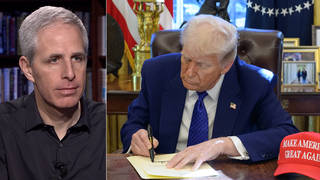
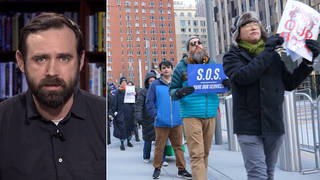

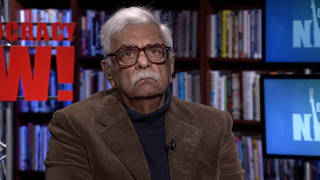
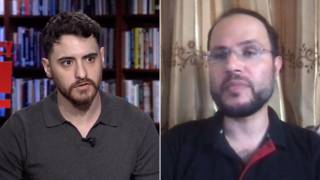


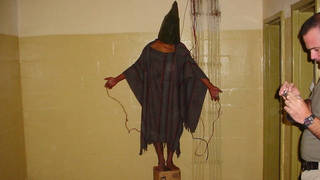

Media Options